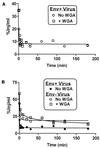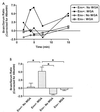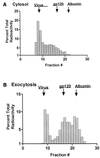Transport of human immunodeficiency virus type 1 pseudoviruses across the blood-brain barrier: role of envelope proteins and adsorptive endocytosis
- PMID: 11312339
- PMCID: PMC114222
- DOI: 10.1128/JVI.75.10.4681-4691.2001
Transport of human immunodeficiency virus type 1 pseudoviruses across the blood-brain barrier: role of envelope proteins and adsorptive endocytosis
Abstract
Blood-borne human immunodeficiency virus type 1 (HIV-1) crosses the blood-brain barrier (BBB) to induce brain dysfunction. How HIV-1 crosses the BBB is unclear. Most work has focused on the ability of infected immune cells to cross the BBB, with less attention devoted to the study of free virus. Since the HIV-1 coat glycoprotein gp120 can cross the BBB, we postulated that gp120 might be key in determining whether free virus can cross the BBB. We used radioactive virions which do (Env+) or do not (Env-) bear the envelope proteins to characterize the ability of HIV-1 to be taken up by the murine BBB. In vivo and in vitro studies showed that the envelope proteins are key to the uptake of free virus and that uptake was enhanced by wheat germ agglutinin, strongly suggesting that the envelope proteins induce viral adsorptive endocytosis and transcytosis in brain endothelia. Capillary depletion showed that Env+ virus completely crossed the vascular BBB to enter the parenchyma of the brain. Virus also entered the cerebrospinal fluid, suggesting passage across the choroid plexus as well. About 0.22% of the intravenously injected dose was taken up per g of brain. In vitro studies showed that postinternalization membrane cohesion (membrane binding not reversed with acid wash or cell lysis) was a regulated event. Intact virus was recovered from the brain endothelial cytosol and was effluxed from the endothelial cells. These results show that free HIV-1 can cross the BBB by an event related to adsorptive endocytosis and mediated by the envelope proteins.
Figures










References
-
- An S F, Groves M, Gray F, Scaravilli F. Early entry and widespread cellular involvement of HIV-1 DNA in brains of HIV-1 positive asymptomatic individuals. J Neuropathol Exp Neurol. 1999;58:1156–1162. - PubMed
-
- Audus K L, Borchardt R T. Bovine brain microvessel endothelial cell monolayers as a model system for the blood-brain barrier. Ann N Y Acad Sci. 1987;507:9–18. - PubMed
-
- Bagasra O, Lavi E, Bobroski L, Khalili K, Pestaner J P, Tawadros R, Pomerantz R J. Cellular reservoirs of HIV-1 in the central nervous system of infected individuals: indentification by the combination of in situ polymerase chain reaction and immunohistochemistry. AIDS. 1996;10:573–585. - PubMed
-
- Balin B J, Broadwell R D, Salcman M, el-Kalliny M. Avenues for entry of peripherally administered protein to the central nervous system in mouse, rat, and squirrel monkey. J Comp Neurol. 1986;251:260–280. - PubMed
-
- Banks W A. Physiology and pathophysiology of the blood-brain barrier: implications for microbial pathogenesis, drug delivery and neurodegenerative disorders. J Neurovirology. 1999;5:538–555. - PubMed
Publication types
MeSH terms
Substances
Grants and funding
LinkOut - more resources
Full Text Sources
Other Literature Sources

